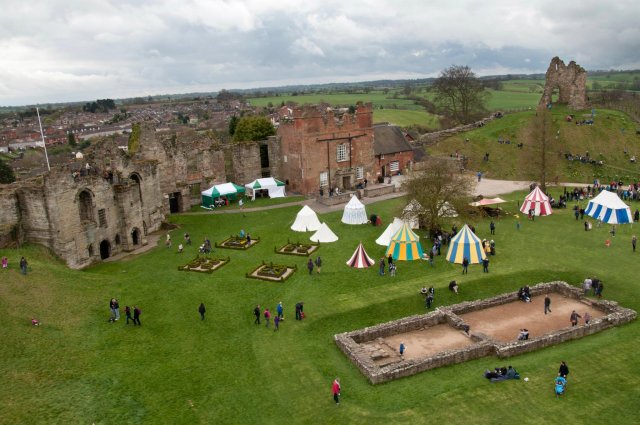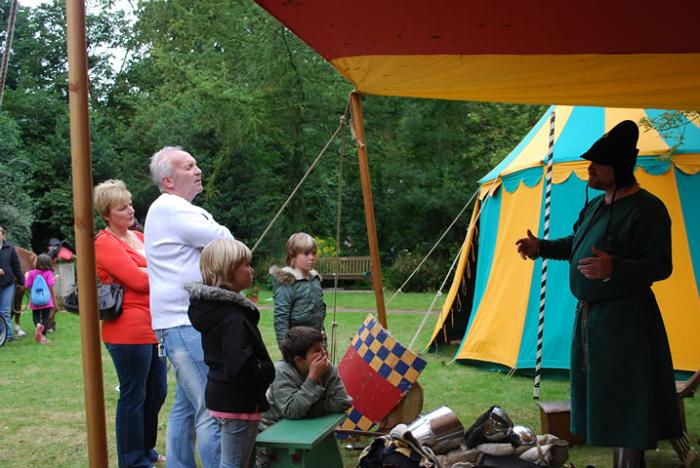Tournee exists to educate the public about the lives of the nobility in the first half of the Fourteenth Century, from 1300 to 1350 during the reigns of Edward I to Edward III. We stage public displays for event organisers across the country, usually for a single day event or for a weekend where the event usually runs from around 10am to 5pm each day.

As part of the event, Tournée can provide short arena events as part of a mixed programme, or for sites which have a more specialised heritage audience we normally provide a full programme of arena events to fill the day.
Our encampment is typically pitched on the evening before the event opens, and is used to accommodate our members throughout the event. All of our tents are of period design, based on manuscript evidence, and are constructed from canvas and wood. Several of our tents will be open during the public hours of the event to display the layout and furnishings including beds, benches, tables and storage in chests and trunks.
Within the camp area, we have static displays of weapons and armour with members who will explain the development of the equipment through our period, and can talk for hours given half a chance. This is also an ideal opportunity to handle the weapons and feel the weight of the armour, and to gain an in-depth understanding of how the protection a knight wears is layered to defend against each of the threats encountered both in the tournament and on the battlefield.
 The camp also features a number of have-a-go activities for children, including some of the simple games of the period and a small version of the Quintain used for training knights to joust. For those found to be misbehaving, a short period in our pillory is usually enough to persuade them to change their ways.
The camp also features a number of have-a-go activities for children, including some of the simple games of the period and a small version of the Quintain used for training knights to joust. For those found to be misbehaving, a short period in our pillory is usually enough to persuade them to change their ways.| Archery demonstrations and a competition between our knights, squires and ladies - shooting with sharp arrows at static and moving targets, individually or in volleys, our archers demonstrate the effectiveness of the bow and crossbow as both hunting weapons and weapons of war. The range of arrow heads available in our period is also demonstrated, and the difference in speed of shooting between a bow and a crossbow is made clear in a timed shoot | |
| Knights in training - demonstrations of the martial skills required of a knight, and how a squire progresses through his training, including participation in mock tournaments using blunted weapons and with only padded armour, known as a behourd or bohort, where sword skills can be developed before the weight of armour is added to the mix | |
| The Art of the Medieval Sword - two knights demonstrate that a sword is a weapon requiring a high degree of skill, and which is more than simply an edged blade with a point on it. Swords could be used in a number of ways, and advanced techniques to disarm your opponent or disable him are introduced and demonstrated as part of a scripted combat, where the knights then re-run the combat in sections while explaining what they are trying to achieve and how the weapon plays its part in their chosen attack or defence. Having broken the combat down to its components, a third run through gives the now-enlightened audience a chance to see it through new eyes, and to cheer on the victor once again! | |
| The Pace Egg - a medieval mummers play with song, comedy and mighty blows struck by the gallant St George against a dragon and the bold Slasher. Firmly tongue in cheek, the play is based on the traditional Easter performances in the north of England, and has a reputation for being somewhat fluid in its delivery, to the delight of the audience who can cheer and boo along. | |
| Arming the Knight - starting in their underclothes, one or two of our knights are dressed by their squires, showing the layering of protective garments and armour and explaining the function of each piece and how it is attached to the knight. Once fully dressed, the knight is close to invulnerable to most attacks, but at the cost of extra effort to carry the armour and move in it. | |
| The Tournament and mêlée - with all of the knights now in full armour, the tournament is a formal occasion for demonstration of the wealth and power of the nobility, who cannot resist using it to settle old scores and stir up the political currents in the kingdom. Fought with honour and bravery, the rules are clear and enforced by the Marshall, but it is common for these events to degenerate into a free-for-all, the mêlée, where the Marshall stands aside and the rules are suspended. Now it is a fight to the yield or beyond! |
